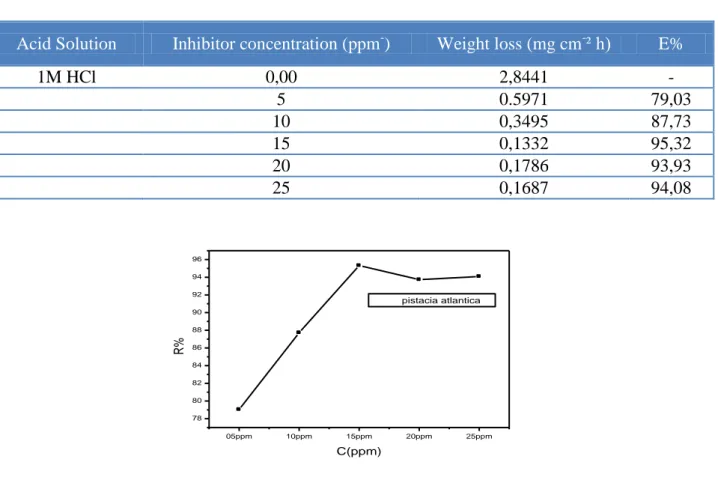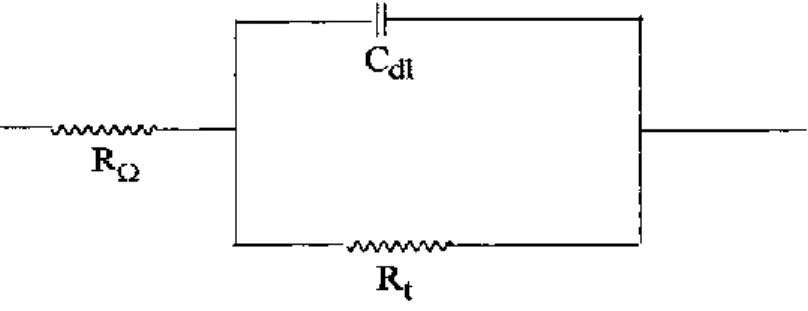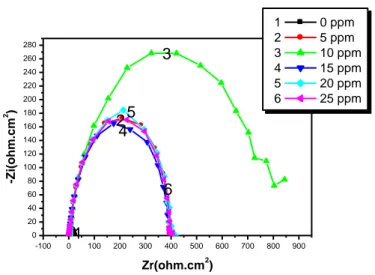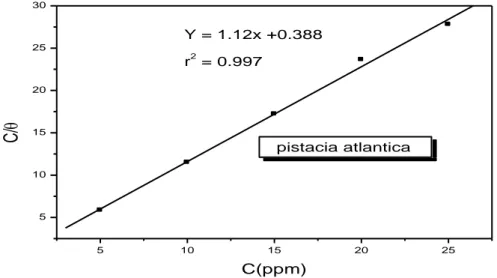Int. J. Electrochem. Sci., 9 (2014) 3969 - 3978
International Journal of
ELECTROCHEMICAL
SCIENCE
www.electrochemsci.org
Green Approach to Corrosion Inhibition by Ethyl acetate
Extract from Pistacia atlantica Gals in Hydrochloric Acid
Solution
M. Dekmouche1,*, M. Saidi1, M. Hadjadj1, Z.Ghiaba1, M.Yousfi2
1
Laboratoire de Valorisation et Promotion des Ressources Sahariennes, Université Kasdi Merbah de Ouargla, 30000 Ouargla, Algeria
2
Laboratoire des Sciences Fondamentales, Université Amar Telidj- Laghouat, 03000 Laghouat, Algeria
*
E-mail: mdakmouche@gmail.com; mokhsaid@yahoo.fr
Received: 21 January 2013 / Accepted: 20 February 2014 / Published: 14 April 2014
In this work, the ethyl acetate extract from the gals of Pistacia atlantica has been studied as inhibitor mild steel X52 in hydrochloric acid (1M HCl) solution using weight loss, polarization and AC impedance methods have been used the corrosion inhibition efficiency increases on increasing plant extract concentration. Polarisation studies showed that Pistacia atlantica extract gals were cathodic – type inhibitors in 1M HCl. Adsorption characteristic of the extract were approxilated by the Langmuir isotherm.
Keywords: corrosion, mild steel, Pistacia atlantica, gals, medium acid, electrochemical techniques.
1. INTRODUCTION
Acid solutions are used for the removal of undesirable scale and rust in many industrial processes such as sulphuric acid [1]. Aggressive acids predominantly sulphuric acid are widely used for industrial and some specific treatments (e.g chemical cleaning pickling) of mild steel, most especially when intended for hot-dip galvanizing. However, these acids are known to cause severe corrosion problems [2]. In order to minimize the loss of mild steel, the use of inhibitors is one of the most practical methods for protection against metallic corrosion. Many organic compounds containing polar atoms such as oxygen, nitrogen, sulphur and phosphorus in their molecular structures have been used as corrosion inhibitors for metal [3-13]. While sulphur containing inhibitors exert their best efficiency in sulphuric acids [14-16] such as sulphoxides, sulphide and thioureas [17]. Inhibitors find application in pickling cleaning and acid descaling processes in general organic compounds such as,
amines acetylenic alcohol, heterocyclic compounds etc, have found use as inhibhtors in industrial applications [18]. But unfortunately, most of them are highly toxic to both human beings and environment. Hence, the use of natural products which are eco-friendly and are being used as corrosion inhibitors of natural source and non-toxic type has been considered more important and desirable [19-22], such as the extract of black pepper (Piper nigrum, family of piperaceae) is a rich source of alkaloids such as piperine and traces of other alkaloids as piperidine, piperittine and piperanine [22].
The inhibition effect of Eclipta alba extract in hydrochloric acid solution of 1N on corrosion of mild steel was investigated by weight loss. It was found to be effective corrosion pickling inhibitor [23]. Also, the extracts of Solanum tuberosum were studied as the corrosion inhibitor for mild steel in 1M HCI and H2SO4 medium using different techniques. It was found to be a good corrosion inhibitor
[23]. In our continued effort to contribute to the current search for green corrosion inhibitors to replace the synthetic ones, the present study reports on the corrosion inhibition and adsorption behaviour of Pistacia atlantica as a rich source of polyphenol on mild steel in HCl 1M at room temperature (25±1°C) using weight loss.
2. EXPERMENTAL DETAILS The preparation of extract
Pistacia atlantica gals were collected from plants growing wild in Laghouat in south of Algria in October 2009. The gals were air-dried in shadow at room temperature for two weeks. The dried gals were partially smashed manually before extraction. Five grams of the smashed material were macerated in acetone: water: 7/3 V/V then placed in dark for 72 h at room temperature, followed by filtration. Acetone was removed by using rotator evaporator, the aqueous phase was mixed with 100 mL of petrolum ether, the lower phase was recovered and the extraction was repeated twice successively for the removed of pigments and most of the lipids taken in to the upper phase. The lower phase was washed with ethyl acetate (2x100mL), were performed and resulting organic phase of ethyl acetate was evaporated under vacuum, giving a yellow powder. The concentrations of inhibitors extract used in the studies were 5ppm-25ppm
Corrosion tests have been carried out on mild steel electrodes. Steel stips containing percentage composition of C 0.103, Mn 0.971(in wt. %).
S 0.0021 and remainder iron was used, as the working electrode for the measurement of weight loss and for the electrochemical studies. The surface preparation of the specimens was carried out by grinding with sand paper grade 400 and 2000, they were dried at room temperature before use. The acid solution (HCl 1M) was prepared by dilution of analytical grade 37% HCl (fluka) with distilled water.
The gravimetric measurement were carried out at the definite time interval of 30min at room temperature (25±1°C) using an analytical balance (precision±0.01mg). The experiments were carried in hydrochloric acid solution of 1M (uninhibited and inhibited) on cold-rolled steel. Sheets with dimensions 25x17x5mm were used. They were polished successively with different grades of sand paper vessel containing 50 ml of test solution. A clean wight cold-rolled steel sample was completely
immersed at an inclined position in the vessel. After 30min of immersion in 1M of HCl with and without addition of inhibitor at different concentrations, the specimen was withdrawn, rinsed with distilled water, washed with ethanol, fried and weighted, the weight loss was used to calculate the corrosion rate in mg.cm-2h-1.
Polarization curves were conducted at 25±1°C using an electrochemical measurement system controlled with Tacussel Radiometer PGZ301 corrosion analysis. Electrochemical experiments were carried out in a glass cell with a capacity of 500 ml. A saturated calomel electrode (SCE) was used as a reference electrode. A Pt electrode was used as a counter. All potentials are reported vs. SCE.
For Tafel polarization technique and electrochemical impedance spectroscopy (EIS), the working electrode (we) was in the form of a disc cut from mild steel under investigation and was embedded in a Teflon rod with an exposed area of 1.0 cm2. A calomel electrode was placed close to the working electrode to minimize ohmic resistance. All test solution were aerated in the cell, the test solution was mixed with a magnetic stirrer. The anodic and cathodic polarization curves were recorded by a constant sweep rate of 0.5mV.S-1.
Electrochemical impedance spectroscopy (EIS) was conducted in an electrochemical measurement system (Voltalab40) which comprises a PGZ301 potentiontat and voltalab Frequency Responce Analyser .
A personal computer and VoltaMaster 4 software and pusing a double glass cell equipped with a thermostatic cooling condenser. The solution volume was 500ml. An ac sinusoid±10mv was applied at the corrosion potentials (Ecorr) over a frequency range of 100k Hz -20 mHz with ten points per decade was employed. All tests were performed at 25±1°C. Nyquist polts were obtained from these experiments .
3. RESULTS AND DISCUSSION
3.1. Weight loss measurement and electrochemical studies:
The effect of addition of Pistacia atlantica extract tested at different concentrations on the corrosion of mild steel in 1M HCl solution was studied by weight loss measurement at 25°C after 30min of immersion period. From the values of corrosion rate in the absence (CR(0)) and presence
(CR(i)) of inhibitor, the inhibition efficiency E (%) was calculated according to the following equation
(1) [24] : 100 (%) ) 0 ( ) ( ) 0 ( R i R R C C C E (1)
Where CR(0) and CR(i) are the values of corrosion rate (mg.cm-2.h-1) of mild steel in uninhibited
and inhibited solution, respectively.
It is obvious from the Table 1 and shown from Fig.1 and Fig.2 that the Pistacia atlantica extract inhibit the corrosion of mild steel in 1M HCl solution at all concentrations used in this study, and the corrosion rate (CR) is seen decreasing continuously with increasing additive concentration at
25°C and, corrosion rate values of mild steel decrease when the inhibitor concentration increases while E (%) values of Pistacia atlantica extract increase with the increase of the concentration, the
maximum E (%) of 94,08% is achieved at 25ppm and a further increase in concentration did not cause any appreciable change in the performance of the Pistacia atlantica extract.
In order to obtain a better understanding of the corrosion protection mechanism of Pistacia atlantica extract against the corrosion of mild steel in 1M HCl acid medium, a detailed study on this inhibitor was carried out using electrochemical studies.
Table1. Corrosion parameters obtained from weight loss measurements for mild steel in 1M HCl containing various concentrations of Pistacia atlantica.
Acid Solution Inhibitor concentration (ppm-) Weight loss (mg cm-² h) E%
1M HCl 0,00 2,8441 - 5 0.5971 79,03 10 0,3495 87,73 15 0,1332 95,32 20 0,1786 93,93 25 0,1687 94,08
Figure 1. A plot of variation of inhibition efficiency with different concentrations of Pistacia atlantica extract in 1M HCl on mild steel of surface area of 1cm2.
0 5 10 15 20 25 0 5 10 15 20 C(ppm) V(m m /a n) pistacia atlantica
Figure 2. A plot of variation of rate corrosion with different concentrations of Pistacia atlantica extract in 1M HCl on mild steel of surface area 1cm2.
05ppm 10ppm 15ppm 20ppm 25ppm 78 80 82 84 86 88 90 92 94 96 R% C(ppm) pistacia atlantica
3.2. Polarization measurements
They have been carried out in order to get knowledge concerning the kinetics of the anodic and cathodic reactions. Polarization curves of the mild steel in 1M HCl solutions without and with addition of different concentrations of Pistacia atlantica extract are shown in Fig .3. The anodic and cathodic current – potential curves are extrapolated up to their intersection at a point where corrosion current density (icorr) and corrosion potential (Ecorr) are obtained [25]. Table 2 shows the electrochemical
kinetic parameters (icorr, Ecorr and bc) obtained from Tafel plots for the steel electrode in 1M HCl
solution without and with different concentration of the investigated Pistacia atlantica extract. The icorr
values were used to calculate the inhibition efficiency.
E (%) (listed in Table 2), is calculated by the following expression [26]:
100 1 (%) 0 corr corr i i E (2)
Where icorr and i0corr are the corrosion current densities in the presence and absence of the
inhibitor in the solutions, respectively.
As was expected, cathodic reactions of carbon steel electrode corrosion were inhibited with increase of the naturel product concentration, this result suggests that the addition of the naturel inhibitors reduces anodic dissolution and also retards the hydrogen evolution reaction [24]. The best inhibition efficiency was about 89,92% at concentration 25ppm. This result has shown that the corrosion rate decreased and inhibition efficiency E% increased by increasing inhibitor concentration. The shifting of Ecorr indicates that the corrosion inhibitor is a cathodic inhibitor.
Figure 3. Typical potentiodynamic polarization curves for MS in 1M HCl containing different
concentrations of Pistacia atlantica extract at 25 °C 3.3. Impedance measurement
Impedance measurement of the mild steel electrode at its open circuit potentiel after 30min of immersion in 1M HCl solution, with and without Pistacia atlantica inhibitor were performed over the
-600 -550 -500 -450 -400 -350 1E-4 1E-3 0.01 0.1 1 10 6 5 4 3 2 1 lo g |i| ( m A/ cm 2 ) E/ECS(mV) 1 00 ppm 2 05 ppm 3 10 ppm 4 15 ppm 5 20 ppm 6 25 ppm
frequency range from 100k Hz-2 mHz. Fig .4 shows the obtained Nyquist plots of mild steel in 1M HCl solution in the absence and presence of different concentrations of Pistacia atlantica extract. These curves show a typical set of Nyquist plots. It is clear from these plots that the impedance response of carbon steel has significantly changed after addition of the naturel inhibitors in the corrosive medium. This indicates that the impedance of an inhibited substrate increases with increasing concentration of inhibitor in 1M HCl. It is worth noting that the change in concentration of the naturel
surfactants did not alter the profile of the impedance behaviour, suggesting similar mechanism for the corrosion inhibition of carbon steel by naturel inhibitors (Fig. 4). The impedance parameters, solution resistance, charge transfer resistance Rct and double-layer capacitance Cdl, are listed in Table 2.
The Nyquist plots obtained in the real system represent a general behaviour where the double layer on the interface of metal/ solution does not have as a real capacitor. On the metal side electrons control the charge distribution whereas on the solution side it is controlled by ions. As ions are much larger than electrons, the equivalent ions to the charge on the metal will occupy quite a large volume on the solution side of the double layer [14]. From Table 2,
100 1 1 ) ( 1 t in h t t R R R (3)
The double-layer capacitance Cdl was calculated from the following equation [15]:
t d lR fC
Z
"
max 2 1 (4)Where f(-Zimg) is the frequency at maximum imaginary component of the impedance and Rct are the charge transfer resistances.
Figure 5. The equivalent circuit model for electrochemical impedance measurements
Where Rt(inh) and Rt are the charge transfer resistance values with and without inhibitor for mild steel in acidic medium, respectively [18]. The impedance parameters derived from these investigations are presented in table 2.
As the Pistacia atlantica extract concentrations increased, Rt values increased , but Cdl values tended to decrease (Table 2). The decrease in Cdl values was due to the adsorption of Pistacia atlantica extract on the metal surface. The inhibition efficiency
reached 97.10% in 1M HCl at
10ppm of inhibitor. The inhibition efficiency in 1M HCl was lower. This was presumably caused by the lower surface coverage of the inhibitor on the mild steel surface in the 1M HCl solution.
Table 2. Corrosion parameters obtained from electrochemical and impedance measurements for mild steel in 1M HCl containing various concentrations of Pistacia atlantica extract
Acid Solution conc. Of Pistacia atlantica extract (ppm)
Tafel data Impedance data
Ecorr (mV vs. SCE) icorr (m A cm -²) βa (mV dec-1 ) βc (mV dec-1 ) E% Rct (Ω cm²) Cdl (µ F cm-²) % 1M HCl 0,00 - 474,9 0,598 90,1 -118,2 _ 23,19 412,844 _ 5 - 456,3 0,087 92,4 -111,1 85,45 392, 40 230,382 94,09 10 -456,7 0,078 108,4 -108,6 86,89 800,77 374,746 97,10 15 -448,6 0,077 81,4 -113,3 87,12 394,01 152,451 94,11 20 -461,7 0,092 105,7 -99,6 84,63 414,76 215,408 94,41 25 -450,4 0,064 82,0 -104,4 89,92 396,47 233,596 94,15 It is clear that charge transfer resistance Rct values were increased and the capacitance values Cdl decreased with increasing inhibitor concentrations.
Figure 4. Nyquiste plots of mild steel recorded in 1M HCl containing different concentrations of Pistacia atlantica extract at 25°C.
-100 0 100 200 300 400 500 600 700 800 900 0 20 40 60 80 100 120 140 160 180 200 220 240 260 280 6 5 4 3 2 1 -Zi(o hm.cm 2 ) Zr(ohm.cm2) 1 0 ppm 2 5 ppm 3 10 ppm 4 15 ppm 5 20 ppm 6 25 ppm
Decrease in the capacitance, which can result from a decrease in local dielectric constant and/or an increase in the thickness of the electrical double layer, suggests that the inhibitor molecules act by adsorption at the metal/solution interface [14]. The addition of the synthesized surfactants provides lower Cdl values, probably as a consequence of replacement of water molecules by the synthesized inhibitors at the electrode surface. Also the inhibitor molecules may reduce the capacitance by increasing the double layer thickness according to the Helmholtz model [14]:
The value of Cdl is always smaller with the inhibitor presence than with its absence, as a result of the effective adsorption of the naturel inhibitors.
Results obtained from EIS measurements are in good agreement. The real part (Z’) and imaginary part (Z”) of the cell impedance were measured in ohms at various frequencies.
With that obtained from both potentiodynamic polarization and weight loss measurements. Electrochemical impedance spectroscopy and polarization curves measurements were repeated several times and observed that they were highly reproducible.
4. INHIBITION MECHANISM
The inhibition efficiency afforded by polyphenols from Pistacia atlantica may be attributed to the presence of electron rich O and aromatic rings. [15].
Langmuir isotherm for monolayer chemisorptions is given by the following equation [27]: Cinb/θ = 1/Kads ┼ Cinb (5)
and free energy of adsorption ( 0
ad
G
) were calculated using the relation ships [27] :
0
ad
G
= 2.3RTlog (55.5 Kads) (6)
Where Kads is the equilibrium constant of the adsorption/desorption process. The plots of Cinb/θ.
Cinh yield straight line with nearly unit slope showing that the adsorption of Pistacia atlantica extract
can be fitted to Langmuir adsorption as presented in Fig. 5. and The value of 55.5 is the molar concentration of water in solution the values of adsorption equilibrium constant (Kads) and free. Energy
of adsorption ( 0
ad
G
﴿.
The values of the energy of the adsorption as calculated from the Langmuir –type adsorption isotherm for Pistacia atlantica extract in 1M HCl was -12.30 kj.mol-1.The obtained 0
ad
G
indicate that
the adsorption mechanism of Pistacia atlantica extract on the surface of mild steel surface involves physisorption.it means that ; the inhbitor are able to electrostaatically adsorb on the charged metal[24].
5 10 15 20 25 5 10 15 20 25 30 r2 = 0.997 Y = 1.12x +0.388 C/ C(ppm) pistacia atlantica
Figure 5. Langmuir adsorption isotherm plot for the adsorption of Pistacia atlantica extract in 1M HCl on the surface of mild steel.
5. CONCLUSION
Many plant extracts have been reported to be very effective corrosion for the protection of mild steel in acidic medium [28]. In This study, polyphenols from Pistacia atlantica show excellent inhibition properties for the corrosion of mild steel in 1M HCl at 25°C, and the inhibition efficiency increases with increasing of the Pistacia atlantica extract concentrations, the inhibitor efficiencies determined by weight loss, Tafel polarisation and EIS methods are in reasonable agreement. Based on the polarisation results, the investigated Pistacia atlantica can be classified as cathodic inhibitor. The EIS spectra are described well by a relatively simple structural model having only one time constant. The calculated structural parameters show an increase of the obtained Rct values and a decrease of the capacitance Cdl, with increasingof Pistacia atlantica extract concentrations. It is suggested to attribute this to the increase of the thickness of the adsorption layer at steel surface. The adsorption model obeys to the Langmuir adsorption isotherm and they were in good agreement. They can be used as excellent corrosion inhibitors for steel in acidic medium at room temperature.
References
1. K. F. Khaled, Appl. Sufr. Sci. 230 (2004) 318.
2. S.A. Umoren, M. M. Solomon, I. I. Udosoro, and A. P. Udoh, Cellulose. 17 (2010) 635. 3. B. Ime, I. B. Obot, Portugaliae Electrochimca . Acta. 27 (2009) 539.
4. M. Monika, W. A. Siddique, Portugaliae Electrochimica. Acta. 25 (2007) 443. 5. L. Larbi, O. Benali, Y. Harek, Portugaliae Electrochimica. Acta. 24 (2006) 337. 6. T. Tüken, B. Yazici, M. Erbil, Turk. J. Chem. 26 (2002) 735.
7. L. Valek, S. Martinez, Mater. Lett. 61 (2007) 148.
9. A. M. Al-Mayouf, A. A. Al-Suhybani, A. K. Al-Ameery, Desalination. 116 (1998)25. 10. K. Bekkouch, A. Aouniti, B. Hammouti, S. Kertit, J. Sci. Org. 10 (1990) 20.
11. K. Benchekroun, F. Dalard, J.J. Rameau, A. El.Ghazali, New J. Chem. 26 (2002) 154.
12. N. Tantawy, Annals of the University "Dunarea de Jos" of Galati, Fascicle VIII, Tribology. (2005) 112.
13. A. Barbosa da silva, E. D'elila, J. Antonio da cunha Ponciano Gomes, Corros. Sci. 52 (2010) 788. 14. M. A. Hegazy, Corros. Sci. 51 (2009) 2610.
15. L. Larbi, O. Benali, Y. Harek, Mater. Lett. 61 (2007) 3287.
16. M. A. Quraishi, and J. Rawat, Materials. Performance. 40 (2001) 42.
17. C. Jeyprabha, S. Sathiyanarayanan, G. Venkatachari, App.Sur. Sci. 108 (2001)246. 18. F. Bentiss, M. Traisnel and M. Lagrenée, Brit. Corr. J. 35 (2000) 315.
19. E. E. Oguzie, Portugaliae Electrochim . Acta, 26 (2008) 303.
20. S. A. Umoren, I. B. Obot, E. E . Ebenso, N. O. Oboi-Egbedi, Int. J. Electrochem. Sci. 3 (2008) 1016.
21. M. Dakmouche, S. Ladjel, N. Gherraf, M. Saidi, M. Hadjaj and M. R. Ouahrani, Asian. J. Chem. 21 (2009) 6176.
22. M. A. Quraishi, D. K. Yadav, and I. Ahamad, Open corros. J. 2 (2009) 56. 23. A. Singh, E. E. Ebenso, and M. A.Quraishi, Int. J. Corrosion, (2012) 1. 24. I. Ahamad, R. Prasad. M.A. Quraishi, Corros. Sci., 52 (2010) 1472.
25. F. Bentiss, C. Jama. B. Mernari, H. El-Attari, L. El-Kadi, M. Lebrini, M. Traisnel, M. Lagrenée, Corros. Sci., 51 (2009) 1628.
26. M. S. Morad, A. A. O. Sarhan, Corros. Sci. 50 (2008) 744. 27. A. K. Singh, M. A. Quraishi, Corros. Sci. 52 (2010) 1529. 28. M. Shyamala, and P. K. Kasthuri, Int. J. Corrosion . (2012) 1.
© 2014 The Authors. Published by ESG (www.electrochemsci.org). This article is an open access article distributed under the terms and conditions of the Creative Commons Attribution license (http://creativecommons.org/licenses/by/4.0/).




